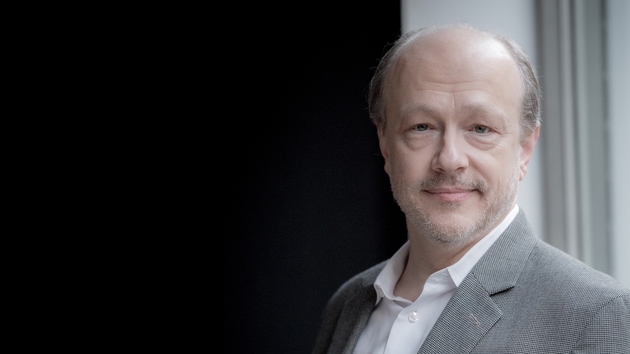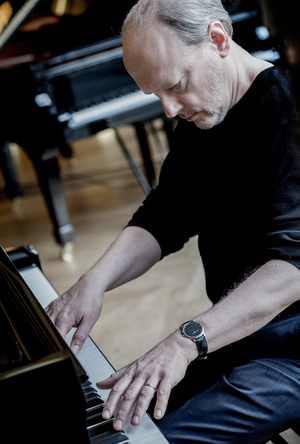
Marc-André Hamelin has been a regular visitor to San Francisco for some time. Yet, until Sunday’s concert as part of the San Francisco Symphony’s “Great Performers Series,” he had not given a solo recital in Davies Symphony Hall. With San Francisco’s biggest concert stage all to himself, he made a case for being one of the greatest artists of today.
Hamelin began with a steely and solemn reading of Bach’s Chaconne in D-Minor. Adhering faithfully to the score, he played the opening measures with his left hand only (an homage to another transcription of the same piece by Brahms, for left hand). His disciplined approach maintained the solemn character of the piece. Even as the variations flourished, at times more Busoni than Bach, the central chord progression remained clear. Hamelin worked hard to fill the large hall, and the effect was akin to being surrounded by organ pipes in all directions — fitting for a Bach transcription.

A resounding low G proclaimed the beginning of Schumann’s Fantasy, Op. 17. With contrast in mind, Hamelin took the idea of pianissimo to a whole other level. In a section immediately following the second theme, the intimacy between lovers — Robert and Clara — was illustrated with perhaps the most hushed sound ever heard in the hall. It was a truly revelatory moment, proving that speaking loudly does not garner attention and the most intimate whisper carries weight. Near silence returned in the coda, with a quote from Beethoven’s song cycle An die ferne Geliebte that seals this love letter from Schumann to his future wife with the lightest but most passionate kiss, revealing extreme tenderness and the true meaning of the piece.
The barely contained joy in the second movement seemed to dance, particularly in the capricious middle section. The infamous coda, with rapid skips in opposite that kept even Liszt from performing it publicly, was tamed like kittens under Hamelin’s hands. But the ease with which Hamelin delivered it raises a question: didn’t the composer want the performer to struggle, or at least convey the challenges to the listeners?
Yet, Hamelin uses his facility not as pyrotechnics at all. Instead, he appears to leverage it to allow himself to step aside from the sometimes convoluted path between composer and audience. While Hamelin has performed and recorded some of the most challenging piano repertoire, he rarely indulges in frivolous contests and so maintains a transparent touch. Such transparency doesn’t rob Hamelin’s performances of charm, surprise, or wit, however.
As such, the spiritual reading of the third movement of Schumann’s Fantasy seemed to be in an entirely different world from the sharply witty transcriptions of Charles Trénet songs by Alexis Weissenberg after intermission.
Hamelin began writing down notes from Weissenberg’s recordings some time ago, before the music was available. It was a herculean task, eventually helped by some unexpected mail from Weissenberg’s daughter, which contained copies of four of the songs. Hamelin has since recorded them, and the score was recently published as well. In performance, Hamelin’s dexterity was up-front, with fast decorative runs filled with sparkles. Yet, it still wasn’t all about Hamelin at all. He remained faithful to the wit and humor of the original chansons, especially the lightheartedly absurd “Boum,” delivered with punches and raucous, ragged rhythms.
Mario Castelnuovo-Tedesco’s Cipressi, Op. 17 provided an atmospheric interlude to clear the air after Weissenberg/Trenet. The haunting, pleading notes evoked Debussy, though there was a more clearly defined tonal center. As a champion of lesser-known composers, Hamelin made a convincing case that the composer is worthy of exploration.
In the end though, Hamelin indulged the audience with an expansive reading of the Chopin Polonaise-Fantasie, Op. 61. Slightly late and rushed notes on the second half of the first beat added excitement. But in the climax, Hamelin was somewhat modest, not quite reaching the epic peaks of some pianists. The Scherzo No. 4, Op. 54 followed with nary a breath, solidifying the extraordinary ease with which Hamelin tackles the most difficult music, an altogether modest display of his abilities that lets the notes speak for themselves.
Hamelin gave his own Toccata on “L’Homme armé,” originally written for the 2017 Van Cliburn Competition, as an encore. If that wasn’t enough, the audience demanded five curtain calls and got a second encore, “Herberge” from Schumann’s Waldszenen, Op. 82.




